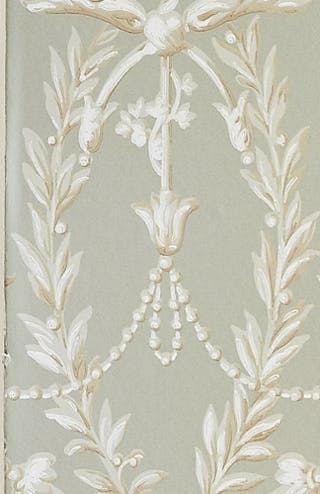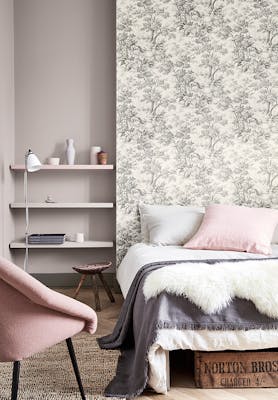
Révolution Papers
The title of this range refers not to the storming of the Bastille in 1789, but to the groundbreaking advances in the production and distribution of wallpapers in the ensuing industrial period.
‘Révolution Papers’ comprises seven designs that typify the period: traditional damask and delicate toile patterns, a sophisticated (and sometimes surprising) treatment of colour and a beautiful surface quality only achieved by traditional block-printing.
Sackville Street c. 1730
One of the largest and best-preserved patterns in the archive, this design features a 39” (99cm) repeat and an unusual 31.5” (80cm) width, so each drop is substantially wider than the standard 20.5” (52cm) wallpaper roll. Found in the rear bedroom of a home built for ‘minor nobility’, the surviving example had originally been papered on boards, with additional flowers added retrospectively by hand to mask the joins in the paper.
Palais c. 1840
A classic interpretation of this pattern, so typical of French wallpaper panels produced by the manufacturer Réveillon from the late 1700s onwards. The design was block-printed in eighteen colours on a narrow 18.5” (47cm) width paper with a vertical repeat of 26.5” (67cm). The original design scale, style and surface treatment have all been maintained, embracing floral bouquets and garlands with drapery and arabesque decoration.
Bonaparte c. 1850
This paper, a revision of an authentic 19th Century French damask, was found more recently as a painted piece of artwork in a Parisian studio. It is a common misconception that colours used in historic decoration were exclusively drab; the rich shades, layering and gradation of colour reproduced here are completely faithful to the original papers, yet exhibit a very contemporary feel.
Stag Toile c. 1895
Taken from an original 19th Century English linen, this single colour print of a woodland stag is much less formal than the typical Toile de Jouy designs which originated in France during the late 18th Century.
Versailles c. 1890
A slightly later paper than its traditional design might suggest, Versailles is based on an original document which was machine printed in graded tones to give a trompe l’oeil effect. In a classic Rococo style, it features scrollwork and cornucopia bursting with flowers.
Piccadilly c. 1790
Less is known about this paper than its comparable partner ‘Soho Square’ (see London Wallpapers), but there are obvious similarities. The archive document of this pattern is a ‘mock flock’, meaning it was designed to carry the appearance of a more expensive flock paper but the effect is achieved through print rather than texture.
Whitehall c. 1740
Found in a medieval property that was at one time home to a Surrey school, there is a clear French influence in this paper. The floral trellis pattern is undoubtedly inspired by textile design; printed linen and fustian fabrics in this style became very popular during the mid 18th Century.
Stag Toile - Bedroom

'Révolution Papers’ comprises seven designs that typify the period: traditional damask and delicate toile patterns, a sophisticated (and sometimes surprising) treatment of colour and a beautiful surface quality only achieved by traditional block-printing.Order your free wallpaper samples today

Period Wallpapers




































